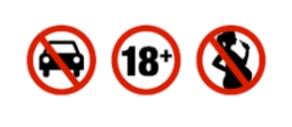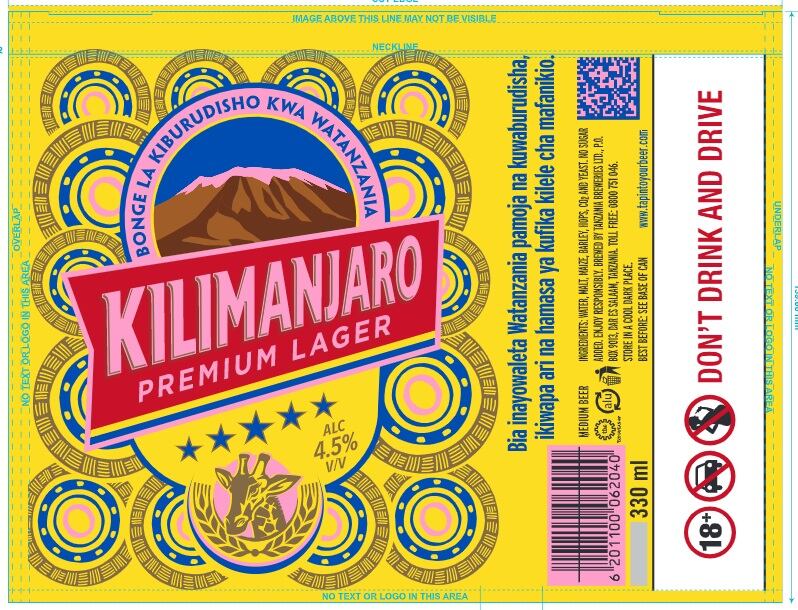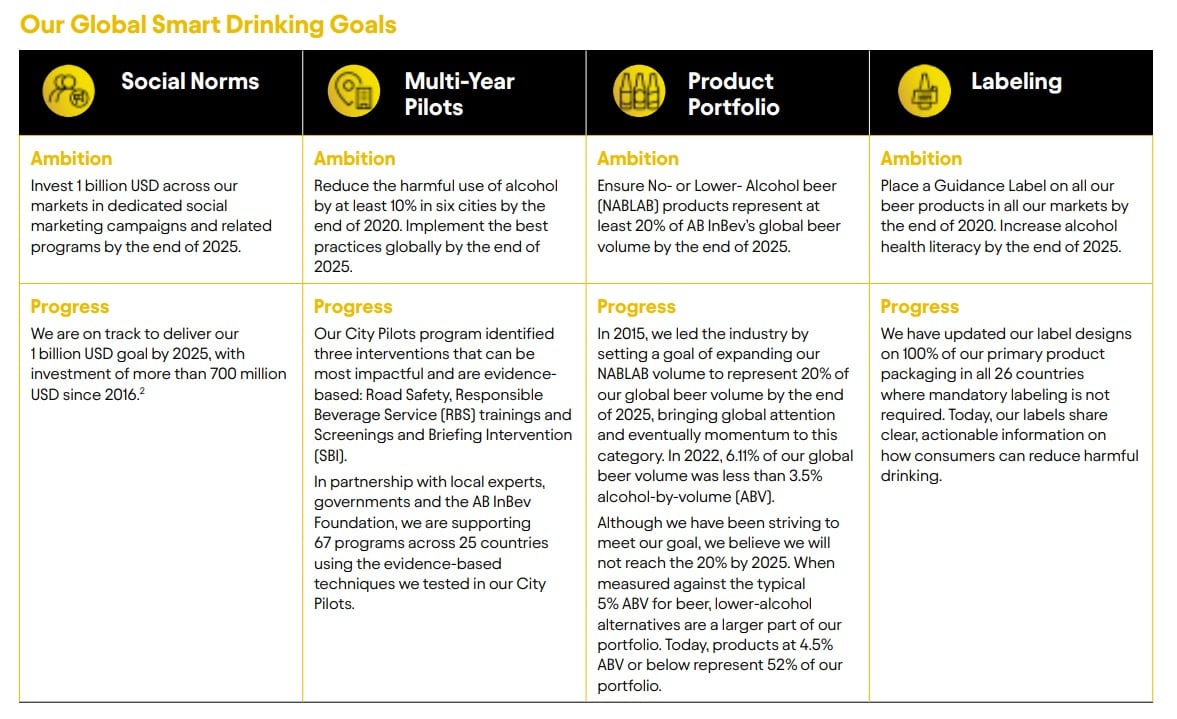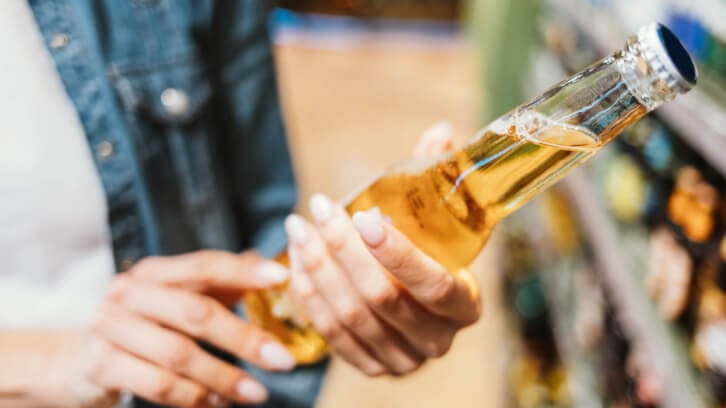More than 500 beer brands now include labels featuring guidance such as ‘don’t drink and drive’ messaging; visual icons to deter underage drinking, drinking when pregnant and drunk driving; links to consumer information websites; and the ABV of each product.
It’s part of AB InBev’s efforts to lead in ‘Smart Drinking’: the idea that every experience with beer should be a positive one and that alcohol companies have a role to play in helping consumers make smart choices while enjoying their products.
Isn't such labeling already a legal requirement?
Many consumers are used to seeing smart drinking messages on bottles, because they are legally required or strongly encouraged under industry initiatives.
But AB InBev’s commitment also covers 26 markets where there is no legal mandate for label warnings – which in fact represents 50% of its global market.
“This was a massive global undertaking that was embraced by our colleagues around the world,” John Blood, Chief Legal & Corporate Affairs Officer, told BeverageDaily.
“The actionable advice messages were developed by leading public health experts and are grounded in the science of social norms marketing which aims to prompt positive behavioral change.”
AB InBev's guidance labels cover:

- Actionable advice: Clear Smart Drinking messages promoting specific behaviors such as “Don’t drink and drive,” “Eat before or while drinking alcohol” or “Alternate your drinks with non-alcoholic drinks” and seven other evidence-based actionable messages.
- Visual icons: Three graphics intended to deter underage drinking, drinking while pregnant and drunk driving.
- TapIntoYourBeer.com: Links to a consumer information website where users can find more information.
- Legibility: Text, font and other standards ensure labels are highly visible and easy to read
- Alcohol By Volume (ABV): Indicates the percentage of alcohol by volume in each product

While the advent of tech such as QR codes has seen companies move to put more information online, Blood champions the immediacy of a physical label and the majority of the company's messaging is delivered on the label.
“We recognize that a label is more than packaging – it is a key consumer touchpoint that can help promote positive consumer behaviors by providing actionable advice and visual reminders for consumers to help underscore moderation," he said.
“Rather than use a QR code, we decided to make the messaging immediate and on the primary packaging of the beer itself.
"Our voluntary guidance labels are on the physical labels of the our beer cans and bottles.
"These labels also include a link to our consumer information website, TapIntoYourBeer.com, were consumers can access product information and Smart Drinking practices.
“In some countries we are also printing our messages on secondary packaging – the outer packaging and containers such as six-pack cartons.”
Challenges in creating alcohol guidance labels
The initiative was not without its challenges. AB InBev began by confirming the country-level lower risk drinking guidelines to be communicated on the initial labels. In many of these countries, however, it found that the governments did not want an alcohol company providing health advice.
Additionally, each market had different local laws and regulations, different brands had varying color and space mandates, and countries had different local messaging around alcohol consumption. The time-intensive process for public health researchers to assess these different factors did not match up with the commercial timelines proposed.
A second challenge was demonstrating the impact of guidance labels. “Without a randomized trial, which would be both logistically complicated and expensive, it was very difficult to systematically measure the guidance labels’ impact on consumer behavior,” noted a 2021 analysis from Georgetown University Business for Impact of how effective AB InBev's Smart Drinking efforts are.
“The argument could be made that, at a minimum, guidance labels would do no harm. However, the labels came with a significant cost, and in some instances, they could have backfired. For example, one of AB InBev’s labels that reminds consumers to drink a glass of water in between alcoholic beverages had the potential to encourage consumers to drink more alcohol because they believed drinking water enabled them to drink more beer, rather than drink alcohol in moderation.”
“Any guidance label should be pre-tested with qualitative research to ensure that the wording, image, and behavioral message will resonate with the audience – and achieve the intended health impact.”
A third concern was how consumers would react to the message being delivered by an alcohol company.
“Pro-health messages disseminated by a brand [as opposed to government or public health authority] could have less credibility as consumers may dismiss them as not being science-based. On the other hand, if consumers see that alcohol companies are recommending moderate use of their product, this could be perceived positively.
“In a study conducted in Canada by the Tufts team, participants did not respond negatively to the labeling, which they knew was an AB InBev initiative."
Effectiveness of Smart Drinking initiatives
So do the labels actually work?
Researchers from Tuft's University in Boston, contracted through the AB InBev Foundation in 2018, suggest that product description labels should include the percent alcohol by volume and number of standard drinks found in the container.
They also suggest that a separate series of health labels should be designed to be rotated on drinks (such as messaging on the country’s low risk drinking guidelines and how the product in question compares to this; as well as labels with messages about diseases and harms associated with alcohol).
While pinpointing the direct effect of AB InBev's labels in particular is tricky, the company says there is 'ample evidence' that proper labeling can help positively alter consumer behavior around alcohol consumption'.
It points to research from the International Alliance for Responsible Drinking (IARD), which states that health warning labels provide consumers with information close to the point of potential consumption and may help to remind them about the risks to their health from excessive or inappropriate drinking.
Meanwhile, the World Health Organization (WHO) also reports that labels can be considered as part of a comprehensive strategy to provide information and educate consumers to prevent and reduce alcohol-related harm.
And the company also highlights its involvement with Tufts in developing an open-source consumer guidance labeling strategy for beer, with "evaluation findings showing that providing actionable advice was key to bringing about positive behavioral change."
‘We want every experience with beer to be a positive one’
Blood says that AB InBev 'not only recognizes our responsibility to encourage positive drinking behavior, but also believe this is an opportunity to help shift social norms in the communities in which we live and work.'
“We strive to make every experience with beer a positive one, and promote moderation by investing in evidence-based solutions and scaling them around the world," he said. "By providing guidance labels, we are working to ensure that consumers are empowered to make smart choices while enjoying our products.”
AB InBev’s Smart Drinking Goals are spread across four key areas. Alongside guidance labelling, that includes running social marketing campaigns and growing its range of low and no alcohol products.

“For instance, we have created Responsible Beverage Service (RBS), which is a training program for community point-of-sale professionals, such as store owners and bartenders, focused on promoting positive consumer behaviors,” explained Blood.
“In partnership with the AB InBev Foundation, we are currently deploying 17 RBS training programs across 9 countries, training approximately 18,000 staff members covering over 17,000 establishments. We are also working to make RBS training more accessible, easier to scale and more impactful by taking it online and connecting it to our commercial digital platforms. Last year, using our digital platforms, we e-trained approximately 7,500 store owners and bartenders on RBS in the Dominican Republic, Panama and as part of our FIFA World Cup programs. We continue to expand RBS at a rapid rate using technology so that it can reach more people.
“We also believe that we can deliver meaningful messages to consumers about moderation through our products and brand campaigns. This is why in 2015 we committed to investing $1bn through 2025 to promote social norms marketing. We are on track to achieve that goal as we continue to execute impactful Smart Drinking campaigns all over the world.
“To encourage creativity and embed these concepts into the brand marketing processes, we launched our first annual Social Marketing Competition five years ago and receive over 100 submissions every year. This past year, the winning campaign from Corona Cero encouraged consumers to share a no-alcohol beer with their friends. Four of our Smart Drinking campaigns received awards at the 2021 Cannes Lions Festival of Creativity which recognizes leading global marketing campaigns, including the 2020 Aguila “Live Responsible” and Brazil “Responsible Billboards” campaigns.”

